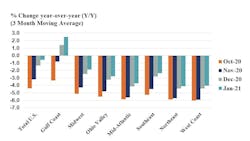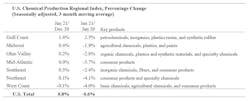ACC: U.S. chemical production rises in January
WASHINGTON, March 1, 2021 (PRNewswire) — The U.S. Chemical Production Regional Index (U.S. CPRI) rose 0.8% in January following a 1.4% gain in December and a 1.1% gain in November, according to the American Chemistry Council (ACC). During January, chemical output expanded in nearly all regions. The Gulf Coast region showed the largest gain, with smaller gains seen in the Midwest, Southeast, Ohio Valley, and Northeast regions. Output was flat in the Mid-Atlantic region and edged lower in the West Coast. The U.S. CPRI is measured on a three-month moving average (3MMA) basis.
Chemical production continued to expand in chlor-alkali, fertilizers, organic chemicals, synthetic rubber, plastic resins, manufactured fibers, industrial gases, and synthetic dyes and pigments, measured on a 3MMA basis. Production eased for coatings, adhesives, crop protection, consumer products, and other specialty chemicals.
As nearly all manufactured goods are produced using chemistry in some form, manufacturing activity is an important indicator for chemical demand. The manufacturing recovery continued for a sixth consecutive month in January, with overall factory activity up by 1.0% (3MMA). The trend in production increased in many key chemistry end-use industries, with the strongest gains seen in food and beverages, appliances, motor vehicles, aerospace, construction supplies, fabricated metal products, iron and steel products, petroleum refining, oil and gas extraction, plastic products, structural panels, textile products, and furniture.
Compared with January 2020, U.S. chemical production remained off by 0.6% on a year-over-year (Y/Y) basis, the twentieth straight month of Y/Y declines, but showed continued improvement compared with earlier in the year. Chemical production remained lower than a year ago in all regions except in the Gulf Coast region, which was up 2.5% Y/Y.
The chemistry industry is one of the largest industries in the United States, a $565 billion enterprise. The manufacturing sector is the largest consumer of chemical products, and 96% of manufactured goods are touched by chemistry. The U.S. CPRI was developed to track chemical production activity in seven regions of the United States. The U.S. CPRI is based on information from the Federal Reserve, and as such, includes monthly revisions as published by the Federal Reserve. To smooth month-to-month fluctuations, the U.S. CPRI is measured using a three-month moving average. Thus, the reading in January reflects production activity during November, December, and January.

